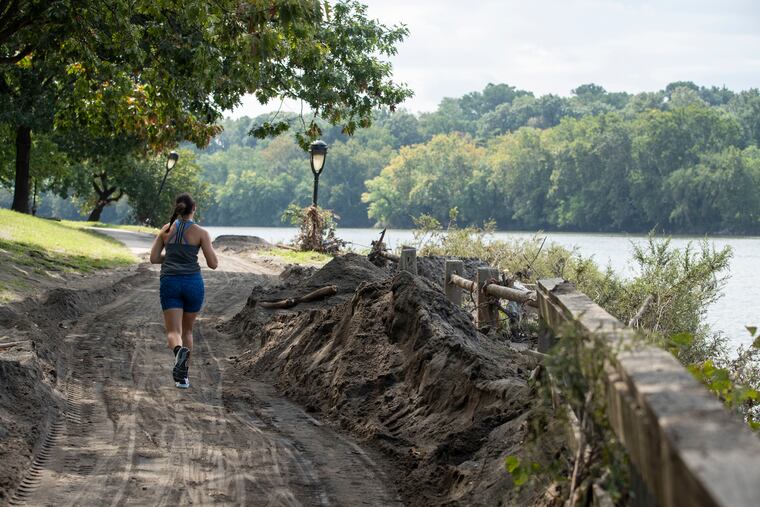Enjoying the Schuylkill River Trail after Ida: What’s open, closed, and alternate routes
What you need to know about biking, walking, or running the Schuylkill River Trail.

Hurricane Ida left the Schuylkill River Trail (SRT) underwater, and while the floodwaters have since drained, some sections of the area’s most popular running and cycling trail remain impassable.
Here’s what to know if you’re looking to travel the trail in the coming days.
Note: Trail conditions are evolving. The 75-mile trail stretches through Philadelphia, Schuylkill, Montgomery, Chester, and Berks Counties. Check with your local county’s Parks and Recreation department for the latest conditions.
» READ MORE: How to help victims of Ida from Philly
Trail conditions by county: what’s open, partially open, and closed
Philadelphia
Thanks to cleanup efforts by city workers, community organizations, and volunteers, the SRT section that stretches through the city has mostly reopened. Martin Luther King Drive (west of the Schuylkill River and on the opposite side of the SRT) is now fully open to pedestrians, too.
However, the Manayunk Canal towpath, a two-mile stretch between Lock Street and Shawmont Avenue, remains closed for repairs.
Philadelphia Parks and Recreation says a timeline for reopening is still being determined, and significant cleanup remains, including the removal of over a foot of silt, mud, and sediment in some parts of the trail, in addition to boardwalk repair and replacement of fencing that secures the trail from the Manayunk Canal.
“This section experienced significant damage and is dangerous for passage on foot or bicycle,” says Maita Soukup, Philadelphia Parks and Recreation director of communications.
Montgomery
This week, some parts of the SRT that run through Montgomery County temporarily reopened. However, due to safety concerns, all sections of the trail in Montgomery County are now closed. This includes from the Manayunk Towpath through Phoenixville and out to Pottstown. A reopening timeline has not been set. “While various entrances of the SRT remain open, we are still discouraging trail use at this time as cleanup efforts continue,” says Kelly Cofrancisco, communications director for Montgomery County. “Trail use at this time can actually hamper and slow down our efforts.”
Berks and Schuylkill
The section of the SRT that runs through Berks and Schuylkill Counties was not damaged as much by Hurricane Ida as in other areas and is now fully open.
» READ MORE: The best places to buy bikes in Philadelphia
Alternate routes
If SRT closures are cutting your bike ride short, there are plenty of other great routes across the region. Check out the Philadelphia Bicycle Coalition’s route library to get started, which maps out rides ranging from one to 80 miles. For a longer ride, Amanda Ruffner, communications manager for the Philadelphia Bicycle Coalition, recommends the 15-mile Navy Yard / FDR Park / Stadiums loop or the 23-mile Ben Franklin Bridge / Cooper River loop.
Preparing for dusty or muddy riding conditions
While much of the SRT is now reopened, sand, silt, and mud are still present in many areas of the trail. I This can make for a dustier and slower ride for cyclists. “It’s definitely doable. I saw a lot of people out on Indego bikes and other non-mountain bikes, but I’d consider the weather just because of how dusty it is,” says Ruffner, noting that rain can create muddier and more dangerous conditions.
Until all remaining mud and debris is cleared, trail users are encouraged to use extra caution. Ruffner recommends cyclists wear sunglasses or another form of eye protection. “You might even want to bring a neck gaiter or mask depending on how windy it’ll be during your ride,” she says.
You should also carry a fix-a-flat kit or other tire repair tools. It’s a good item to have on all rides, but with the extra debris currently on the SRT, your tires are even more susceptible to punctures.
“Try to ride when visibility is good so the sandy parts don’t sneak up on you,” says Ruffner. “From personal experience it was much harder to notice the sandy parts later in the evening.”
Slow down if you’re forced to navigate muddy or sandy patches, and pay extra consideration to other riders, especially when passages narrow due to mud and debris. Currently on the Philly side of the SRT, the trail narrows both across from the entrance to the Laurel Hill Cemetery and around the construction bollard after the East Falls Bridge. “By far the sandiest part is right before the Columbia Train Bridge,” Ruffner says, noting that you may need to dismount and briefly walk, depending on the style of your bike.
As for all closed sections of the SRT, you’re urged to stay off the trail for your own safety. This applies to not just cyclists, but runners and walkers, too. According to the EPA, flood water residue contains pathogens, parasites, and chemicals. .
“It’s also important to avoid closed areas to be respectful of and not disrupt the cleanup operations — folks are putting a lot of hard work into getting these areas back into good and safe shape for public use,” says Ruffner.
Want to help with the cleanup?
Schuylkill River Greenways National Heritage Area plans to organize several volunteer work days in Berks and Montgomery Counties. Email (info@schuylkillriver.org) or call (484-945-0200) to find out about upcoming opportunities.
» READ MORE: Live your best life in Philly: Read our most useful stories here